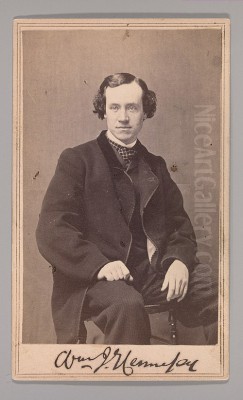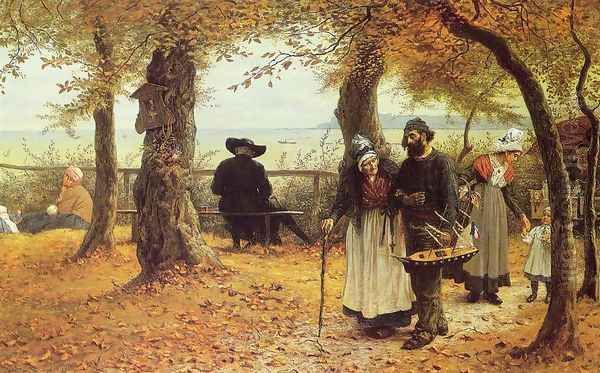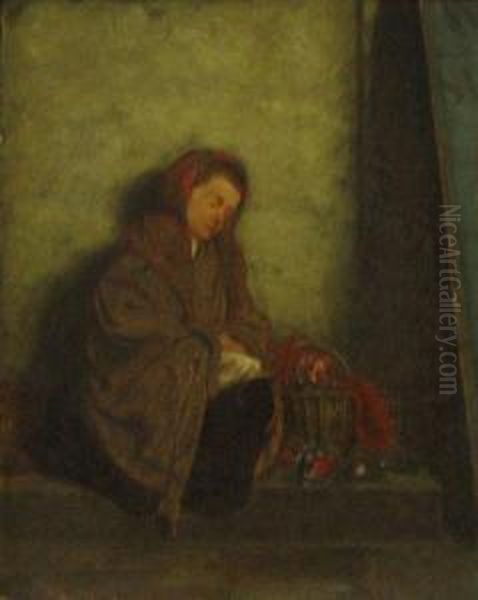
William John Hennessy (1839-1917) stands as a fascinating figure in nineteenth and early twentieth-century art, an artist whose career bridged the burgeoning art scene of America with the established traditions of Europe, particularly London. Born in Thomastown, County Kilkenny, Ireland, on July 11, 1839, Hennessy's life was shaped from an early age by the political and social currents of his time. His story is one of talent, migration, adaptation, and a quiet dedication to his craft, encompassing painting, illustration, and a commitment to the artistic community.
Early Life and Emigration to America
The Hennessy family's trajectory was profoundly impacted by the political turmoil in Ireland. John Hennessy, William's father, was involved in the Young Irelander Rebellion of 1848, a nationalist movement seeking Irish independence. As a consequence of his participation, he was compelled to flee Ireland, initially finding refuge in Canada before settling in New York City. This forced emigration set the stage for a new chapter for the family.
In 1849, a young William, along with his mother Catherine and his brother, made the arduous journey across the Atlantic to join his father in New York. This city, a burgeoning metropolis and a melting pot of cultures, would become the environment where William's artistic talents first began to blossom. The experience of immigration, the displacement from his homeland, and the adaptation to a new world undoubtedly colored his perceptions and, perhaps subtly, his artistic output.
Artistic Awakening in New York
New York in the mid-nineteenth century was a place of immense energy and growing cultural ambition. It was here that William John Hennessy's innate artistic abilities began to surface. He demonstrated a precocious talent for drawing and painting from a young age. Recognizing this potential, he was enrolled in the prestigious National Academy of Design in New York at the remarkably young age of fifteen, around 1854.

The National Academy of Design was the premier art institution in America at the time, founded on the model of European academies. Here, Hennessy would have received formal training in oil painting, drawing from casts, and life drawing. He made swift progress, and by 1854 (some sources suggest 1857), he was already exhibiting his work at the Academy. This early exposure was crucial for a young artist seeking to establish a reputation. His contemporaries at or associated with the Academy during this period would have included prominent figures of the Hudson River School, such as Frederic Edwin Church and Albert Bierstadt, whose grand landscapes dominated American art. While Hennessy's later style would diverge, the prevailing artistic winds of detailed naturalism would have been part of his formative education.
His talent did not go unnoticed. By the 1860s, Hennessy had become a full member of the National Academy of Design, and in 1862 (or 1863 according to some records), he was elected an Academician (NA), a significant honor that signified his standing within the American art community. This period also saw him develop considerable skill as a wood engraver, a medium vital for illustration in books and periodicals before the widespread adoption of photomechanical reproduction.
The Illustrator's Craft
Beyond his easel paintings, William John Hennessy carved out a successful niche as an illustrator. This was a highly respected and commercially viable field for artists in the nineteenth century, bringing art to a wider public through printed media. Hennessy's skill in wood engraving and his sensitive draughtsmanship made him a sought-after illustrator for some of the leading literary figures of the age.
He created illustrations for the works of renowned poets such as Alfred, Lord Tennyson, the British Poet Laureate; Henry Wadsworth Longfellow, one of America's most beloved poets; and Walt Whitman, the groundbreaking American poet. Collaborating with such literary giants not only provided Hennessy with income and visibility but also placed his work in direct dialogue with the cultural zeitgeist. His illustrations would have required a keen understanding of the texts, an ability to translate poetic imagery into visual form, and the technical skill to prepare designs for the engravers. This work connected him to a broader artistic and literary world, one also inhabited by illustrators like Winslow Homer in America, who similarly began his career in illustration before achieving fame as a painter.
His involvement in illustration demonstrates a versatility and an engagement with popular culture that complemented his fine art practice. The demands of illustration—clarity, narrative power, and adaptability to the printed page—likely honed his observational skills and his ability to compose compelling scenes.
A New Chapter: The Move to London

In 1870, at the age of thirty-one and with a solid reputation established in America, William John Hennessy made a significant life change: he moved to London. The reasons for this move are not explicitly detailed in all accounts, but London, as the heart of a vast empire and a major global art center, would have offered new opportunities, different artistic influences, and access to a wider, more established art market. Many American artists of the period, such as James McNeill Whistler and John Singer Sargent (though Sargent's major London period was slightly later), found London or Paris essential for their careers.
Upon settling in London, Hennessy continued to develop his career. He began exhibiting his work at prestigious venues, including the Royal Academy of Arts, the principal art institution in Britain. His work was also shown at the Royal Hibernian Academy in Dublin, maintaining a connection with his Irish heritage. Between 1879 and 1907, for instance, eight of his paintings were exhibited at the Royal Hibernian Academy. This transatlantic exhibition record underscores his ability to navigate and find acceptance in different art worlds.
His integration into the British art scene was further solidified in 1902 when he became a member of the Royal Institute of Oil Painters (ROI). Membership in such an institution was a mark of peer recognition and provided further opportunities for exhibition and professional association. In London, he would have been exposed to a diverse range of artistic styles, from the lingering influence of the Pre-Raphaelites like Dante Gabriel Rossetti and John Everett Millais, to the academic classicism of figures like Frederic Leighton, and the emerging aesthetic movements.
Artistic Style: A Fusion of Influences
William John Hennessy's artistic style is often described as a distinctive blend, primarily focusing on landscape painting and genre scenes—depictions of everyday life. His work is noted for combining what some sources call a "quasi-Impressionistic precision" and others a "Pre-Raphaelite precision" with the atmospheric qualities of French Naturalism. This suggests an artist who was observant of contemporary trends but forged his own path.
The "Pre-Raphaelite precision" points to a meticulous attention to detail, a clarity of form, and often a bright palette, characteristics championed by the Pre-Raphaelite Brotherhood in the mid-nineteenth century. Artists like William Holman Hunt exemplified this detailed approach to nature and subject matter. Hennessy's application of this precision, however, seems to have been tempered or evolved.

The "French Naturalist atmosphere" refers to the influence of a movement that gained prominence in France in the latter half of the nineteenth century, with artists like Jean-François Millet and, more directly relevant to Hennessy's period, Jules Bastien-Lepage. Naturalism focused on realistic depictions of rural life and landscapes, often imbued with a sense of sober truthfulness and an emphasis on the effects of light and atmosphere. Hennessy's penchant for outdoor scenes, particularly landscapes, aligns well with this sensibility.
The term "quasi-Impressionistic" suggests an interest in capturing the fleeting effects of light and color, though perhaps not with the full, broken brushwork and subjective color of core French Impressionists like Claude Monet or Camille Pissarro. It implies a modern sensibility in his observation of the natural world, moving beyond purely academic or romanticized depictions. He worked proficiently in oils and watercolors, and his skills extended to drawing and woodcuts, showcasing a versatile command of different media.
His subjects often involved figures within landscapes, suggesting a narrative or anecdotal quality, typical of genre painting. He sought to capture the essence of a place and its inhabitants, whether in the Normandy countryside, the fields of England, or earlier, the landscapes of New England.
Notable Works and Exhibitions
Several works by William John Hennessy are cited as representative of his oeuvre. "The Pride of Dieppe" (1879) and "The Votive Offering" (1875) are two such paintings. While images and detailed descriptions of these specific works are not always readily available in general summaries, their titles suggest genre scenes, possibly with narrative or sentimental elements, characteristic of much Victorian and late 19th-century painting. "The Pride of Dieppe" likely depicts a scene from the French coastal town, a popular subject for artists due to its picturesque qualities and maritime life. "The Votive Offering" hints at a scene with religious or devotional overtones.
A particularly notable work mentioned is "A New England Barberry Picker," which was exhibited at the Royal Academy in London in 1871, shortly after his arrival. This painting would have served as an introduction of his American-themed work to a British audience. The subject matter – a quintessential New England scene – demonstrates his continued connection to his American experiences even after relocating.
His consistent exhibition record at the National Academy of Design in New York, the Royal Academy in London, and the Royal Hibernian Academy in Dublin, among other venues, speaks to a productive and recognized career. These exhibitions placed his work before the public and critics, and alongside the leading artists of his day.
Social Conscience and Professional Affiliations
Beyond his personal artistic endeavors, William John Hennessy demonstrated a commitment to the welfare of his fellow artists. He was a co-founder of the "Artists' Fund Society." This organization was established with the philanthropic aim of providing financial assistance to artists and their families facing hardship due to illness, old age, or bereavement. Such societies were vital in an era before widespread social safety nets, reflecting a communal spirit among artists. This involvement speaks to Hennessy's character and his sense of responsibility towards his professional community.
He was also an honorary member of the American Society of Painters in Watercolours, indicating his continued ties with the American art world and his recognized skill in that medium. His membership in the Royal Institute of Oil Painters further underscores his professional standing in Britain. Through these affiliations, he would have interacted with a wide array of artists, sharing ideas and contributing to the collective artistic life of his time. One can imagine him associating with other genre and landscape painters in these societies, perhaps figures like Birket Foster in the watercolor societies, or various Royal Academicians.
His ability to maintain connections with American publishers for his illustration work even after moving to London, and his development of a broad social circle in Europe, further paint a picture of an artist who was not only talented but also adept at navigating the professional and social landscapes of his era.
Later Years and Legacy
In 1893, William John Hennessy made a return to the United States, though this appears to have been a temporary period. He eventually settled back in England, choosing the county of Sussex for his final home. Sussex, with its picturesque countryside and proximity to the coast, has long been attractive to artists. He continued to live and presumably work there until his death on December 27, 1917, at the age of 78.
Assessing the full impact of an artist like Hennessy, who worked across different countries and in various media, can be complex. He may not have achieved the towering fame of some of his more revolutionary contemporaries, such as the leading Impressionists or Post-Impressionists like Vincent van Gogh or Paul Cézanne, who were active during the later part of his career. However, Hennessy's contribution lies in his consistent production of quality work, his skill as an illustrator that brought art to a wider audience, and his role as a transatlantic artist who successfully navigated different art worlds.
His paintings, with their blend of careful observation, atmospheric sensitivity, and often narrative interest, found appreciation in their time. His landscapes and genre scenes captured aspects of life in America, France, and England. The influence he had on later artists might be subtle, perhaps through his students (though specific names are not readily available in general biographical sketches) or through the general artistic milieu he contributed to.
His work is represented in various collections, and his illustrations remain as a testament to his collaboration with major literary figures. He represents a type of artist crucial to the fabric of the art world: skilled, professional, adaptable, and engaged with the artistic currents of his time without necessarily being a radical innovator. His career reflects the increasing internationalism of the art world in the late nineteenth century. Artists like Thomas Eakins in America, while deeply rooted in Philadelphia, also engaged with European training and ideas, reflecting a similar, though differently manifested, transatlantic dialogue.
Conclusion
William John Hennessy's life and career offer a compelling narrative of an Irish-born artist who found his footing in America and further honed his craft in the established art centers of Europe. From his early recognition at the National Academy of Design in New York to his membership in the Royal Institute of Oil Painters in London, he demonstrated a sustained commitment to his art. As a painter of landscapes and genre scenes, he captured the nuances of the environments he inhabited, blending a detailed precision with an appreciation for atmosphere and naturalism.
His significant work as an illustrator for poets like Tennyson, Longfellow, and Whitman highlights his versatility and his role in the broader cultural landscape of the nineteenth century. Furthermore, his involvement in charitable organizations like the Artists' Fund Society reveals a man with a social conscience and a dedication to his professional community.
Though perhaps not a household name in the grand sweep of art history dominated by avant-garde movements, William John Hennessy's artistic journey across the Atlantic, his skillful fusion of stylistic influences, and his diverse contributions as a painter and illustrator secure him a notable place among the many talented artists who shaped the visual culture of their era. His work remains a quiet testament to a life dedicated to the pursuit of art, reflecting the changing worlds he inhabited.